Sweetening Shelves
For smaller stevia companies, competing with larger manufacturers feels “like riding a motorcycle around a semi-trailer truck,” says Jim May, Wisdom Natural CEO.
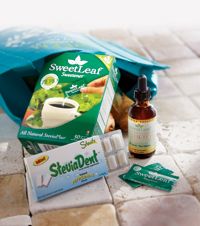
When a neighbor of mine began replacing sugar with stevia in her red velvet cake last month, it was a sweet achievement that was a long time coming. Her mother-in-law, a diabetic, could finally taste the "delicious red crumb-fest" that her daughter-in-law had been bringing to family potlucks for years. "I feel redeemed," says my neighbor with a smile.
Since receiving FDA approval in December, the noncaloric sweetener is turning up in a place critics never thought possible: the grocery aisle alongside white sugar. It's where I found it, and so will "everyone in the next year going out to buy sugar," says Jim May, CEO of Wisdom Natural Brands (Gilbert, AZ). Stevia now officially joins the ranks of three other sweeteners that manufacturers have used to cut calories in consumer food products: aspartame, saccharin, and sucralose.
May, along with others in the stevia business, had always hoped that the sweetener would "become a household name, as ubiquitous as Splenda," May says. He sees it happening in front of his eyes. "It's a natural phenomenon," he continues, "Because in the end, if you have to decide between something that comes from a chemical or from a leaf, which would people choose?"
Stevia has certainly already found a cozy home in mainstream beverages in which it can be effortlessly mixed.
Last fall, stevia made its debut in several consumer beverages. "Primarily, the initial use of stevia was for coffee and teas," says Michael Decker, director of marketing at Cumberland Packing Corp. (Brooklyn, NY), the maker of Stevia in the Raw.
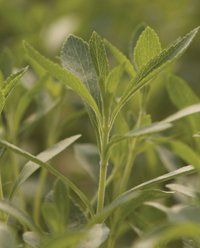
Stevia was advertised as a "natural sweetener" on the labels of Tropicana's Trop 50, an orange juice with half the calories of regular orange juice; Sprite Green, a low-calorie twist on Sprite using Cargill's (Minneapolis) Truvia brand of stevia; and SoBe Lifewater, a low-calorie "power water" using Whole Earth Sweetener Co.'s (South Bend, IN) Purevia brand of stevia.
The average American ingests more than 150 lbs of sugar annually, according to the U.S. Department of Agriculture. That represents a whopping thirty 5-lb bags of sugar each year. Much of this sugar is already prevalent in foods in the form of high fructose corn syrup, which is cheaper and easier to manage in production than sucrose, the common tabletop sugar.
Although stevia is more expensive to manufacture, less of the product is necessary to deliver the same sweet results. "The average conversion rate of sugar to stevia is one cup of sugar per one teaspoonful of pure stevia extract," says Lisa Jobs, author of one of the first stevia cookbooks on the market, Sensational Stevia Desserts. "Clearly, very little stevia is needed to replace sugar. When used in beverages, stevia dissolves quickly and easily and, depending on your taste preference, only a pinch is needed."
Some may argue that stevia is sometimes needed in higher amounts than what Jobs claims since the sweetness of stevia depends entirely on the purity of its leaf. Rebaudioside A (Reb A) is considered the purest, sweetest part of the stevia plant, the part that suppliers are so eager to cultivate properly.
Crude stevia leaves and herbal powder are reported to be 10–15 times sweeter than table sugar. The refined extracts of stevia, called steviosides, are touted to be 200–300 times sweeter than table sugar. The herbal powder is extremely sweet, while the refined extract can be even sweeter and needs to be diluted to be properly used. "Both products have a slightly bitter aftertaste," says Jobs.
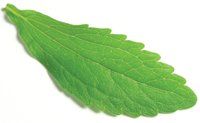
Because of the possible bitter aftertaste, and the volume in a recipe that is lost by using less stevia than sugar, "the real challenge to using stevia effectively is always knowing what ingredients to use in a recipe to make up for the volume and consistency lost with the elimination of sugar, especially in baked goods. That's why it's a good idea to use stevia recipes when you're starting out," Jobs says.
The challenge now is for smaller stevia manufacturers to keep their cards in the game. Dealing with the competition feels "like a motorcycle riding around a semi-trailer truck," says Wisdom Natural's May.
Encouraging marketers to use stevia in their products will be on everyone's mind at the Stevia World 2009 forum, taking place this month in Shanghai. The forum aims to showcase the "who's who" in the stevia sector, including top stevia growers, refiners, traders, key stevia organizations, government officials, scientists, and investors.
WHO'S THE SWEETEST OF THEM ALL
By Shazia Haq, Senior Associate Editor
Disclaimer: This is not a scientific poll. The results reflect only the opinions of those who chose to participate.
IT WAS A LAZY Saturday afternoon, and stevia was on my mind. Which stevia brand was actually the sweetest? It would be interesting to conduct a double-blind unscientific study of my own. At a friend's birthday party that weekend, I decided to put stevia to the test.
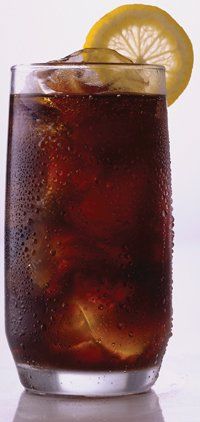
"Listen up, distinguished party guests," I said. "We're going to conduct a little experiment." The idea was simple: gather a group of people together, and ask them to sample various stevia brands and vote on which was the sweetest.
After making a trip to the local grocery store, I returned with every stevia brand I could find on the store shelf. I found four.
The sweeteners that I used in my experiment were: Whole Earth Sweetener Co.'s Purevia, Wisdom Natural Brands' SweetLeaf stevia, Cumberland Packing Corp.'s Stevia in the Raw, and Cargill's Truvia, along with a packet of Splenda and white sugar for comparison. I poured iced tea into plain, small white glasses labeled 1 through 6, and mixed one packet of each sweetener in each different glass.
After tasting all six samples, the party guests were asked to place their six glasses on the table in ascending order of sweetness.
Approximately 70% of people chose Stevia in the Raw or Splenda as the sweetest-tasting iced tea. Every other brand seemed to fall into various ranks of sweetness after that.
After drinking a glass of Stevia in the Raw, a woman from Redondo Beach, CA, said, "This glass definitely seems much sweeter than any of the others."
After drinking a glass of Splenda-sweetened iced tea, a man from Los Angeles said, "Well, this one is definitely Splenda."
The interesting fact: no one could distinguish the iced tea that contained white sugar. It seemed interchangeable with the stevia brands.
Good news for stevia manufacturers.
The market-share numbers look promising. "Reb A can overtake chemical sweeteners in the sweetener markets, because consumers want natural products," says William Mitchell, CFO of stevia supplier PureCircle (Florham Park, NJ). He projects that stevia has the potential to penetrate 20-25% of the sugar market and reach $10 billion in a few short years.
China is currently the world's largest grower of stevia. The cultivation area is concentrated in four provinces: Jiangsu, Anhui, Shandong, and Heilongjiang. Other provinces, such as Sichuan, Xinjiang, Hainan, and Guangdong, are also starting stevia cultivation, according to Murali Dharan, CEO of Mianzhu Gold Tree Agro-Tech, who will be a panelist at Stevia World.
"The infrastructure in China is already laid, from the growing and harvesting, to transportation and extraction companies. In fact, there are already quite a few extraction companies," Dharan says.
Another Stevia World 2009 panelist, Sourabh Agarwal, managing director of Stevia Biotech Ltd. (New Delhi), is now heading up the very first registered stevia brand in India. Agarwal says that the company's target operations are to put in place the very first large-capacity stevia processing plant in India by 2010.
Smaller companies like Wisdom Natural are already experiencing promising business. May says that more than 130 food and beverage companies have already approached Wisdom Natural, curious about branding Wisdom's brand of stevia, SweetLeaf, into their products. "The companies run from everything imaginable: ice cream, cereal, you name it," he says.
The problem companies face, he says, is not building partnerships with brands, but building a quality product. He says that many companies may be tempted to use low-quality steviosides and a filler to make products. "If this is what companies plan on doing, they'll eventually lose," he says. "Some stevia brands use alcohol sugars and maltdextrin, or other forms of sugar to blend their products with. Purified water to extract steviosides is the only way to go."
Stevia does have some drawbacks, though. It does not caramelize as sugar does. Meringue may be difficult to make with it, since stevia does not brown or crystalize as sugar does. The kinks are still being worked out.
But for now, people can rest easy knowing that for some, the mass-production of stevia means they can finally take that first bite of a very delicious piece of cake.
ORGANIC STEVIA
IT MAY BE CONSIDERED new to market, but stevia is already branching off into more-specialized versions to target specific customers. Two companies, Navitas Naturals (Novato, CA) and NOW Foods (Bloomingdale, IL), now offer organic versions of stevia.

Touting its Sweet Tooth stevia as the "purest and least-processed form of stevia on the market," Navitas Naturals is trying to carve a name for itself by offering premium raw stevia in its powder form, the way that "nature intended," says the company. After the stevia leaves are collected, they are dried and milled into a fine powder at low temperatures to protect the nutrients of the plants. The company's reasoning behind this processing is to respect the traditions of the Guarani and Mato Grosso Indians, who crushed whole stevia leaves to create a natural, potent green powder.
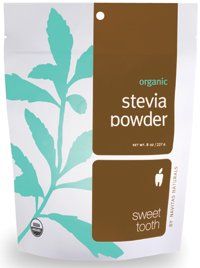
NOW Foods is also serving up organic stevia, claiming that its certified-organic stevia extract is one of the purest forms of stevia on the market. Perhaps to emphasize the purity of its product, the company quotes Genesis in its advertisements: "Then God said, 'I give you every seed-bearing plant on the face of the whole earth and every tree that has fruit with seed in it. They will be yours for food.'"
The impact of GLP-1 on supplements, functional foods, and retail: a webinar from CRN
January 29th 2025The recent CRN webinar discussed GLP-1 medications' impact on supplements, functional foods, and retail, covering consumer trends, global market insights, retailer strategies, industry implications, and future opportunities for innovation.

.png&w=3840&q=75)

.png&w=3840&q=75)



.png&w=3840&q=75)



.png&w=3840&q=75)




